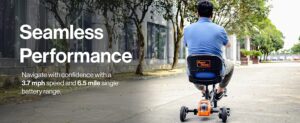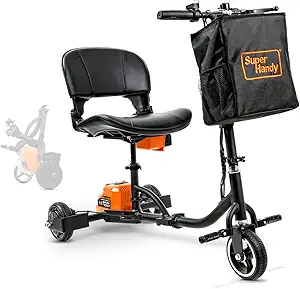Discover the evolution of airplane-friendly mobility scooters, starting with early innovations that revolutionized movement. Manufacturers now prioritize lightweight, foldable designs with quick folding mechanisms for easy transport. Integration of lithium-ion batteries ensures enhanced performance and longer travel distances. Regulatory standards focus on safety and compliance with aviation regulations. The future holds promises of even more innovative solutions for air travel accessibility, with airlines investing in compact, lightweight mobility aids, extended travel ranges, and smart technology implementation. Explore how these advancements continue to shape the convenience and independence of passengers with disabilities in air travel.
Early Innovations in Mobility Devices
Early innovations in mobility devices revolutionized the way people with mobility challenges navigated their surroundings. Before the modern advancements we see today, individuals relied on basic assistive tools like canes and crutches.
The introduction of wheelchairs in the 17th century marked a significant milestone, providing a more efficient means of movement. As technology progressed, so did mobility devices.
The 20th century saw the emergence of electric wheelchairs, offering increased independence and freedom of movement for users. These electric wheelchairs paved the way for the development of mobility scooters, which further transformed the lives of individuals with mobility impairments.
Mobility scooters provided a more convenient and versatile option for navigating both indoor and outdoor spaces. These early innovations laid the foundation for the sleek and practical designs we now see in modern mobility devices. Each iteration brought us closer to the compact and travel-friendly mobility solutions we have today.
Compact Design for Travel Convenience
With the increasing demand for travel-friendly mobility solutions, the focus on compact design has become paramount. Mobility scooter manufacturers have been striving to create designs that aren’t only functional but also easy to transport.
Compact mobility scooters are lightweight and foldable, making them ideal for travel by plane, train, or car. These scooters often feature quick and simple mechanisms for folding and unfolding, allowing users to easily pack them into a car trunk or carry them onto an airplane. The compact design also ensures that the scooters take up minimal space in crowded airports or public transportation vehicles.
In addition to being travel-friendly, compact mobility scooters are designed with user convenience in mind. They’re agile and easy to maneuver in tight spaces, making them suitable for indoor use in shops, restaurants, and other crowded places.
The compact size also allows for better storage options in homes or apartments with limited space. Overall, the focus on compact design has revolutionized the mobility scooter industry, providing users with convenient and versatile solutions for their travel needs.
Integration of Lithium-Ion Batteries

The integration of lithium-ion batteries has significantly enhanced the performance and efficiency of modern mobility scooters. These batteries are lightweight, have a high energy density, and can be recharged quickly, making them ideal for use in mobility devices. With lithium-ion batteries, mobility scooters can now travel longer distances on a single charge, providing users with increased independence and freedom to move around without worrying about running out of power.
Additionally, lithium-ion batteries have a longer lifespan compared to traditional lead-acid batteries, reducing the frequency of replacements and maintenance costs for scooter users.
The use of lithium-ion batteries also contributes to a more environmentally friendly option as they’re rechargeable and produce fewer pollutants during use.
Regulatory Standards and Compliance
Pivoting from the advancements in lithium-ion batteries for mobility scooters, ensuring regulatory standards and compliance is paramount in the manufacturing and distribution of these devices.
When it comes to mobility scooters designed for air travel, adherence to aviation regulations is crucial to guarantee safety and accessibility. Manufacturers must comply with specific standards set by organizations like the Federal Aviation Administration (FAA) to ensure that these scooters meet the necessary criteria for air travel.
These standards often focus on aspects such as battery safety, weight limits, dimensions, and disassembly capabilities for security screening. Compliance with these regulations not only ensures the safety of passengers and crew but also streamlines the boarding process for users of mobility scooters.
Additionally, manufacturers must consider international regulations if they plan to distribute their scooters globally. Understanding and adhering to varying regulations in different countries is vital to ensure that the scooters can be used safely and legally across borders. By meeting these regulatory standards, manufacturers can enhance the usability and acceptance of airplane-friendly mobility scooters worldwide.
Future Trends in Air Travel Accessibility

As advancements in technology continue to shape the future of air travel, accessibility for individuals with mobility challenges is becoming an increasingly significant focus. Airlines are investing in innovative solutions to enhance the overall travel experience for passengers with disabilities. One prominent trend is the development of more compact and lightweight mobility aids that are specifically designed for air travel. These next-generation mobility scooters aren’t only easier to transport and store on aircraft but also provide increased comfort and functionality for users.
Moreover, advancements in battery technology are allowing for extended travel ranges, reducing the need for frequent recharging during layovers. Airlines are also exploring the implementation of smart technology in mobility devices, enabling features like remote diagnostics and real-time tracking for improved maintenance and security.
In addition to technological innovations, there’s a growing emphasis on universal design principles in the development of airport infrastructure and aircraft interiors. This includes features such as adjustable seating configurations, accessible lavatories, and improved boarding ramps to ensure a seamless and dignified travel experience for all passengers.
Frequently Asked Questions
Can Mobility Scooters Be Taken on Cruise Ships?
Yes, you can take mobility scooters on cruise ships. Ensure you check with the cruise line beforehand for specific guidelines. Most ships accommodate mobility aids, offering accessible cabins and ramps for smooth navigation during your voyage.
Are There Restrictions on Using Scooters on Trains?
You can use scooters on trains, but there may be restrictions. Check with the train company beforehand. Make sure your scooter meets size and weight limits. Consider foldable models for easier transportation. Safe travels!
What Are the Rules for Using Scooters in Airports?
When using scooters in airports, follow guidelines for safety. Always yield to pedestrians, stay in designated lanes, and be mindful of your surroundings. Remember to comply with airport security regulations for a smooth travel experience.
Do Airlines Provide Assistance With Scooter Transportation?
Yes, airlines offer assistance for scooter transportation. They can help with boarding and stowing the scooter. Notify them in advance to ensure a smooth experience. Remember, it’s important to follow the airline’s guidelines for mobility assistance.
Are There Weight Limits for Mobility Scooters on Planes?
Yes, there are weight limits for mobility scooters on planes. It’s essential to check with your airline beforehand to ensure your scooter meets their requirements. They will provide you with all the necessary information.
Conclusion
In conclusion, airplane-friendly mobility scooters have come a long way in terms of innovation and convenience. With compact designs, integrated lithium-ion batteries, and adherence to regulatory standards, these devices have greatly improved accessibility for travelers with mobility challenges. As technology continues to advance, we can expect even more improvements in the future, making air travel more inclusive and accommodating for all passengers.

